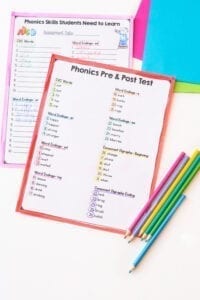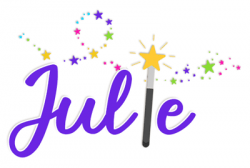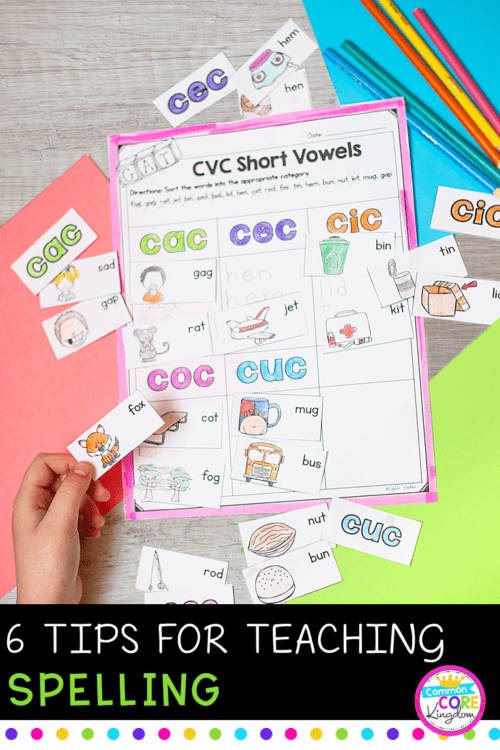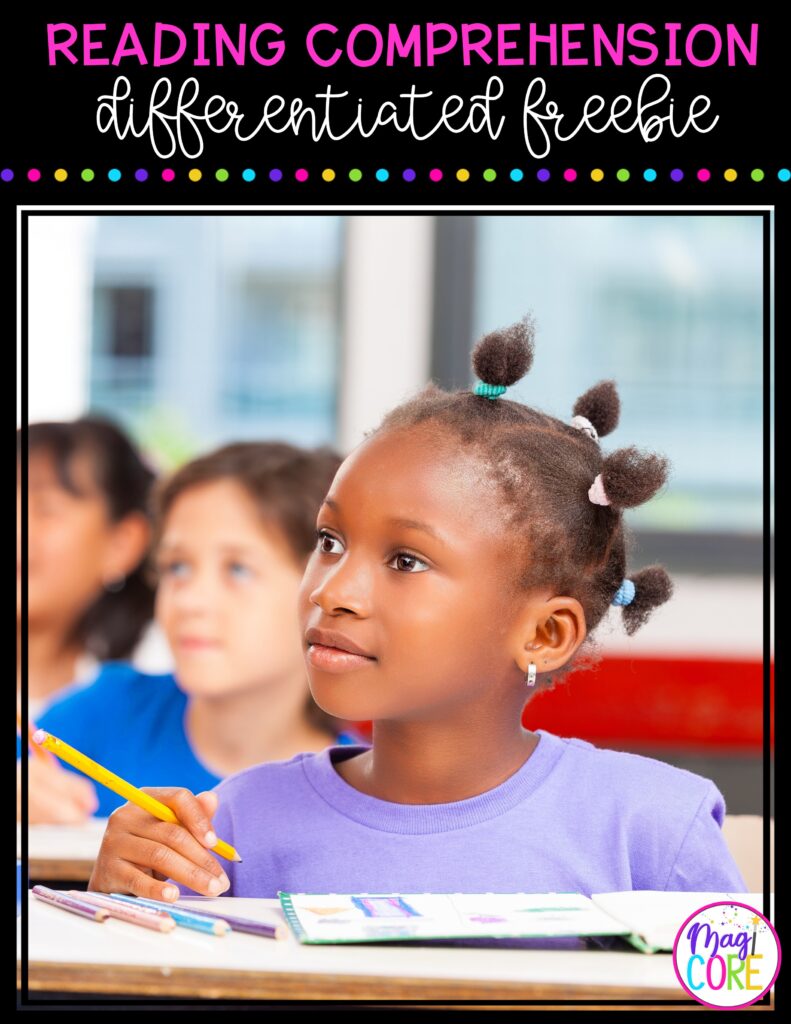Phonics and spelling instruction… I will honestly say teaching spelling and phonics was one of my least favorite things to do. That was because I was doing it all wrong. I knew it because it was ineffective, and I didn’t know how to teach spelling effectively. I was using the prescribed random spelling lists in my basal reader, which were completely unconnected and forced rote memorization. I didn’t spend much time in class to teach or practice spelling (mainly because I didn’t know how – except by having students write the words over and over!), and students were not studying at home. (Can you blame them?!)
When I moved to second grade, I knew effective phonics instruction was critical. I didn’t want to ignore the problem that our basal program caused and that I previously perpetuated. I had to figure out how to teach spelling effectively. I did some research on effective spelling and phonics instruction. I knew that teaching students how words work and learning spelling patterns was the way to help my students succeed. I found “Words Their Way” and ended up using it for a few years. I LOVED the program because I was teaching students how to analyze words and their patterns. It made sense to them, and I saw a huge improvement with my students. They were more engaged in word study, and they became more interested in words and language. We exercised DAILY in the classroom rather than just an expectation for homework.
After a few years of using the Words Their Way, I was having a consistent challenge with many of my students with learning disabilities. I knew that these students needed more explicit instruction on word patterns than Words Their Way provided, and others in the class could benefit as well.
I wanted to do even better for my students, so I decided to create my own spelling curriculum. It includes individualized spelling lists and many of the interactive aspects of Words Their Way, which was SO effective, but it also incorporated more explicit teaching.
I started teaching each spelling pattern explicitly as part of the curriculum, and it worked wonders in my classroom.
I always start the year with a diagnostic test. I use this test to determine what skills my students have already mastered and what skills are lacking. I use the results of the diagnostic testing to determine the differentiation I will use with my class. If you’re already partway through the school year, you can still use a diagnostic test upon implementation of these strategies.
 2. Differentiation:
2. Differentiation:I always taught inclusion ESE classes. The class population generally ranged from students who are nonreaders to gifted students who read on a fourth-grade level by the end of the year. Because of the wide range of ability in my classroom, differentiation was the key to helping everyone in the class succeed.
Differentiating spelling may sound like a lot of work, but it is really not very difficult to manage as long as you have set routines in place. You can start small and use as much or as little differentiation as you are comfortable with.
Minimal Differentiation Strategy
Start by giving all students the same core spelling list and teaching all spelling/phonics lessons to the whole class. From there, simply make accommodations for your below and above level students. Accommodations can include cutting down spelling lists. Some of my special needs students would only get 5-10 words per week. These students would still participate in all class lessons and activities in which we worked on all of the words. I hoped they would still begin to internalize the spelling patterns which applied to all words on the master list even though they were only responsible for a few words on their own smaller lists.
Whole class lessons include activities such as sorting the words, doing word finds in independent reading books, having class discussions about words, playing games, and completing practice pages such as the ones found in my spelling and phonics packet. Even if my class has the same core spelling list, I make a point to meet with my lowest struggling readers at least 2-3 times per week to review the words and provide extra practice.
One benefit of giving students the same core list is that some of your low students will rise to the occasion and be successful with a difficult list that they might not otherwise be pushed to learn. It also makes classroom management and planning easier because every student is doing the same thing at the same time. The negative side of using the same core list is some of your low and high students will not get the most out of your teaching.
Maximum Differentiation Strategy
I use the results from the diagnostic test to split my students into 2-3 groups based on their phonics skill level. I do NOT recommend having more than three groups, because too many groups are hard to manage and may be difficult for you to give enough attention and support to each group.
When I have three groups, I divide them by below, on, and above level. I come up with names for each group so that the students know when it is time to meet with me and to avoid labeling issues. It is very important to make sure you have a schedule so the students know the routine and expectations. This will help prevent behavior management issues and wasting time rounding up the groups.
Here is a schedule I used one year:
Hands-on practice with sorting spelling patterns is crucial. Not only does hands-on word manipulation engage students, but it really helps them understand patterns because they are analyzing the words.
I have students complete worksheet practice as well, but I make sure the worksheets go beyond rote memorization. I use worksheets that require students to analyze and manipulate words and patterns.
You certainly do not need to do traditional weekly spelling tests. I chose to continue this for routine sake, and so I could have consistent data showing student progress. Since I had three different spelling groups, my spelling tests looked different than traditional spelling tests. I completed assessments in small groups. As the year went on, my students who were in the above group would assess a partner. I would not have partners do assessments in the on level or below level groups because word pronunciation could be a factor that could impact results.
My groups were fluid and I wasn’t afraid to change them around. For the most part, they stayed fairly consistent from week-to-week; however, I would move students based on their performance. I would also reassess with the diagnostic test on an as-needed basis for certain students, and to the whole class about two times per year.

We strive to create resources that empower teachers and transform student success. We create skill-focused resources that promote critical thinking, enhance student engagement, and incorporate diversity. Our goal is to develop the tools teachers need to reach their students and foster a lifetime of learning.


4 Responses
I don’t know whether it’s just me or if everyone else experiencing problems with your blog.
It seems like some of the text on your posts are running off the screen. Can someone else
please provide feedback and let me know if
this is happening to them too? This may be a issue with my web browser because
I’ve had this happen previously. Kudos
Angelina,
Sorry to hear you are experiencing difficulty. I checked a few pages on multiple computers and phones and could not recreate the issue. I appreciate you bringing it to our attention. Please let me know if it remains unresolved and I can send the content to you via email.
Best wishes,
Julie
Very interested in trying your phonics/spelling curriculum, but I have three questions. First, would it benefit more if students were assessed on a 9-10 cycle instead of a 5 day? Seems this would allow more time to practice the patterns. Second, if I teach 2nd grade why do you recommend 1st/2nd grade bundle for various skill levels? I’m a new teacher and was told I should never give a second grader first grade curriculum, but to just modify the 2nd grade curriculum if a student needed it. And finally, will 23 spelling lists last for an entire school year?
Hello. Thank you for your interest in this resource!
When I taught 2nd grade, I typically used this in a 5 day school cycle, but always have the next week’s words out Friday so kids could have extra time to look over them on the weekend. I also dedicated a block of time each day to run my phonics groups. If this isn’t feasible for you, I would do a longer cycle so you can make time to meet with each group as much as they need. Test it out with your kids to see what works best. If they aren’t mastering the lists, take more time. It doesn’t even have to be a consistent number of days. The main benefit of the consistency is parents and kids know what to expect.
Whether the 23 lists last all year will really depend on how quickly you move through each list, as well as what list your students start on. I used differentiated lists, so the lists lasted all year for the majority of my students, some did not get through them all, and my advanced students got through them and had time to do challenge lists and even create their own.
If all of your students are all on level, there is no need to get the 1st/ 2nd bundle. Many classes have students who are a bit behind, so the bundle allows for differentiation to catch those students up. The main thing is that students who are behind cannot be expected to master more difficult spelling patterns if they do not have a foundation.
I’m not sure what context the advice of the person who’s said never to use first grade curriculum, but I strongly disagree. Differentiation is crucial to student success. If we don’t close gaps for students who are behind, they won’t “catch up”. In my opinion, modifying the 2nd grade curriculum would mean you need to teach the skills and strategies they are lacking, which often would be first grade content.
I hope this helps! Let me know if you need anything else!